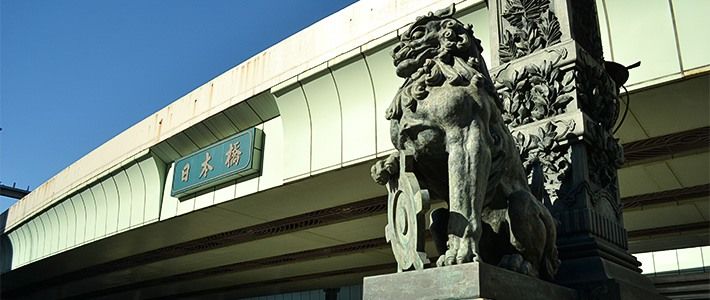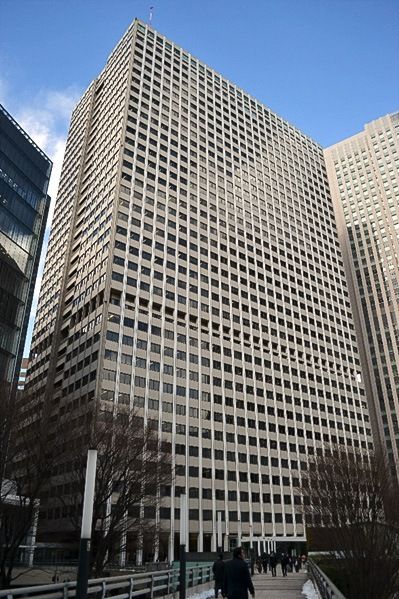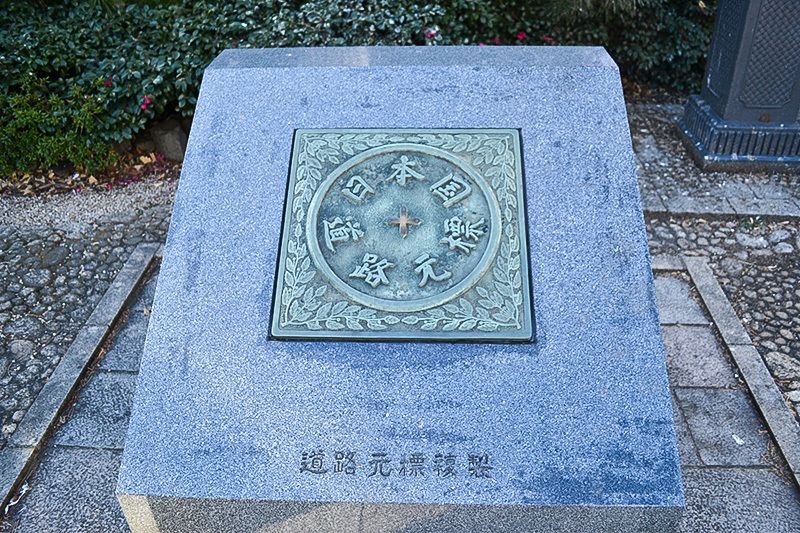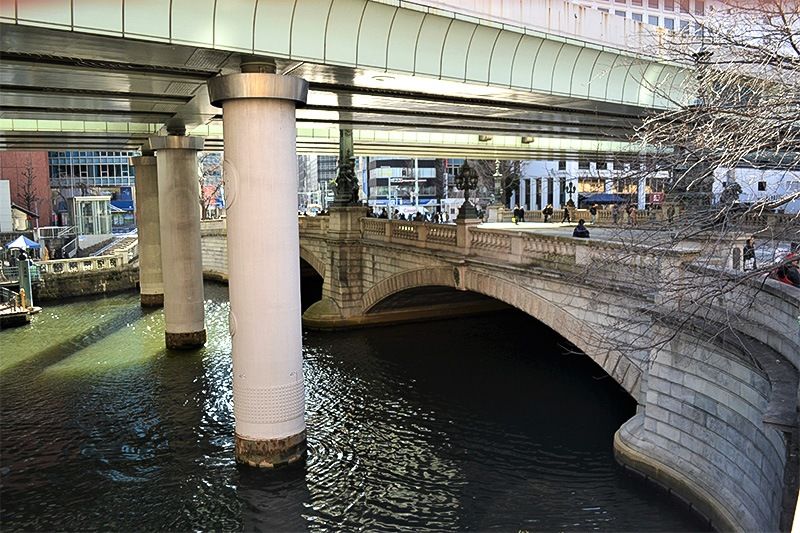
Japan’s Capital from Meiji to the Modern Age
History Culture- English
- 日本語
- 简体字
- 繁體字
- Français
- Español
- العربية
- Русский
Over a span of 100 years beginning in the early seventeenth century, the Tokugawa shogunate transformed Edo from a small village surrounded by scrubby forests and dank marshes into a great bustling city. This transformation was followed by another when the leaders of Meiji-period (1868–1912) Japan employed Western architects and engineers to accelerate the nation’s modernization. They began by lining the main thoroughfares of Edo—now renamed Tokyo—with elegant Western-style stone and brick edifices.
The Great Kantō Earthquake
After the Meiji Restoration of 1868, Western-style buildings dominated Tokyo’s central district where government and corporate offices were concentrated, but the commercial and residential areas remained much as they had always been, large swaths of densely packed wooden buildings. When the 7.9 magnitude Great Kantō Earthquake struck on September 1, 1923, fires broke out everywhere, engulfing the city in flames. The disaster killed more than 100,000 people and left millions homeless.
Numerous Western-style buildings housing offices of the Ministry of Finance, Home Ministry, Metropolitan Police Department, and other government and administrative offices, as well as cultural and commercial structures like the Imperial Theater and the Nihonbashi Mitsukoshi Department Store, were destroyed in the fires. Not even the newly introduced Western architecture was able to withstand the destruction caused by the powerful earthquake.
Gotō Shinpei (1857–1929), who was appointed Home Minister the day after the Great Kantō Earthquake, played a major role in reviving the devastated city. Gotō lost no time in announcing a basic plan for Tokyo’s reconstruction, and on September 27, less than four weeks after the disaster, established an Imperial Capital Reconstruction Council, which he headed himself. Gotō requested a reconstruction budget of ¥4 billion, an amount nearly three times that of the government’s whole operating budget. When the Diet balked, in the end he was only able to secure ¥600 million.
In launching his reconstruction efforts, Gotō asked an old friend, the historian and political scientist Charles Austin Beard (1874–1948), to come to Japan to assist him. Beard immediately sent a telegram advising Gotō to build broad avenues, prohibit the construction of buildings that might block those avenues when toppled, and adopt a consistent approach to the design of the capital’s train stations. At that time, Tokyo was already overcrowded with a population of more than 3 million. Housing was in short supply, streets were narrow and twisted, and sewage and water infrastructure was woefully inadequate. Invigorated by Beard’s advice, Gotō included measures in his reconstruction plan to address the numerous problems that had plagued the city since well before the great earthquake.
The large-scale reconstruction project led to the building of major avenues, including Yasukuni-dōri, cutting east-to-west across the center of the city, and Harumi-dōri and Showa-dōri, intersecting in the Ginza district, as well as lush green zones like the Sumida and Hamachō parks. The last section between Ueno and Tokyo stations on the JR Yamanote loop line was finally completed in 1925, after reluctant landowners who had been blocking the construction gave way following the earthquake and subsequent fires.
The numerous roads and facilities built after the earthquake and the large-scale reallocation of urban land that was carried out at the same time formed the foundations for the Tokyo of today.
The earthquake and fires triggered an exodus of people from the city center to the suburbs. Many were people of culture and intellect and it became a status symbol to have a residence in the suburbs and such nearby cities as Kamakura and Urawa. The boom in suburban housing projects that ensued also lead to the building of new rail lines linking the suburbs to the city center.
The World War II Bombing of Tokyo
Thanks to the blistering pace of rebuilding efforts, Tokyo was back on its feet in an incredibly short time after the Great Kantō Earthquake. The newly created cityscape would not last long, though; the city was once again burned to the ground just two decades later in the firebombing of Tokyo at the end of World War II. The city endured 106 bombing raids from November 1944 to the end of the war. The worst is said to have been the March 10, 1945, bombing of the Fukagawa area of the city, which killed more than 100,000 people. The repeated bombings flattened most of central Tokyo, leaving it a burned and barren wasteland.
Again, however, reconstruction proceeded at a fast pace, and in just a little over a decade, Tokyo had returned to its prewar level of economic activity. To remedy an acute labor shortage, junior high school graduates from outlying areas were brought into the city en masse. These young workers played a significant part in Japan’s rapid economic growth thereafter. Determined to showcase its postwar revival to the world, the country rushed to complete the Tōkaidō Shinkansen, the world’s first high-speed train line, and the inner-city Metropolitan Expressway in time for the 1964 Tokyo Olympics. Japan’s first modern office skyscraper exceeding 100 meters, the Kasumigaseki Building, was completed in 1968. Revisions in 1968 to the City Planning Act and 1971 revisions to the Building Standards Act accelerated the redevelopment, leading to a city center filled with high-rises.
 Japan’s first skyscraper, the Kasumigaseki Building, erected in 1968. It is 147 meters high, with 36 floors above ground and 3 basement floors. It remains a fully functioning office building more than 50 years later, but today does not even make the top 100 ranking of Japan’s skyscrapers.
Japan’s first skyscraper, the Kasumigaseki Building, erected in 1968. It is 147 meters high, with 36 floors above ground and 3 basement floors. It remains a fully functioning office building more than 50 years later, but today does not even make the top 100 ranking of Japan’s skyscrapers.
Another Tokyo Olympics and Nihonbashi
Preparations are underway for a second Tokyo Olympics in 2020. Tokyo has attained maturity as a modern metropolis and changes in infrastructure and facilities will not be as dramatic as they were in 1964, but there is a strong push to counter possible cyberattacks, prepare infrastructure for automatically driven vehicles, and, of course, ensure that the city is ready for the next natural disaster. The process of constant rebirth and transformation continues unabated, and yet there are aspects of Tokyo that never seem to change. This is because, no matter how extensive the superficial changes, Tokyo’s foundations remain firmly grounded in the Tokugawa shogunate’s city of Edo.
The reconstruction work carried out after the Great Kantō Earthquake and the World War II bombings followed the outlines of the moats and canals surrounding and leading into Edo Castle. Subway lines run alongside the castle’s former outer moat and the city’s main avenues and expressway routes trace the many canals weaving through the city. Additionally, many of the government buildings, universities, and parks in the city center are located on the large parcels of land that were once the site of daimyō mansions.
 A replica of the plaque marking Nihonbashi as the starting point of Japan’s five major highways, mounted in a marker stone at the foot of the bridge. The original plaque is embedded in the center of the roadway crossing the bridge.
A replica of the plaque marking Nihonbashi as the starting point of Japan’s five major highways, mounted in a marker stone at the foot of the bridge. The original plaque is embedded in the center of the roadway crossing the bridge.
The first Nihonbashi bridge was built by Tokugawa Ieyasu when he established his capital at Edo in 1603. Since the beginning of the Edo period the bridge has been the official starting point of the five major highways leading out of the capital, and there is a plaque embedded in the middle of the bridge commemorating this. The current stone bridge, with its double arches, was built in 1911 and miraculously survived both the Great Kantō Earthquake and World War II, though it still bears the scars of fire and bombings.
 The original Nihonbashi was a wooden bridge built at the start of the Edo period. The current double-arched stone bridge, the nineteenth reconstruction, was built in 1911. It survived both the Great Kantō Earthquake and the fire-bombings of World War II and continues to function as part of the city’s road infrastructure.
The original Nihonbashi was a wooden bridge built at the start of the Edo period. The current double-arched stone bridge, the nineteenth reconstruction, was built in 1911. It survived both the Great Kantō Earthquake and the fire-bombings of World War II and continues to function as part of the city’s road infrastructure.
The Ministry of Land, Infrastructure, Transport and Tourism and the Tokyo Metropolitan Government are now considering plans to dismantle the overhead portion of the Shuto Expressway that currently obscures the historical bridge and run the expressway underground instead. This project to improve views of Japan’s most famous bridge is planned to begin at some point after the 2020 Olympic and Paralympic Games. The capital’s expressway network was completed in 1963, one year before the first Tokyo Olympics. At that time, building the expressway over the city’s canals, including the waterway crossed by Nihonbashi, was considered the fastest and most economical way to complete the project in time for the Olympics.
It is symbolic of both Tokyo’s constantly changing façade and its simultaneous immutability that more than half a century later, new plans are underway to restore the sky over Nihonbashi and recapture its former glory.
(Originally written in Japanese by the Nippon.com staff. Banner photo: Nihonbashi overshadowed by the Metropolitan Expressway.)